Interpretable Calibration of Crystal Plasticity Model Using a Bayesian Surrogate-Assisted Genetic Algorithm
Abstract
1. Introduction
2. Methodology
2.1. Optimization Algorithm
2.2. BNN-Based Surrogate Model
2.2.1. Hyperparameters and Structure of BNN
2.2.2. Data Processing
2.2.3. Implementation and Training of the Surrogate Model
2.3. MCDropout-Based BNN-Assisted GA
2.3.1. Infill Sampling Criteria
2.3.2. Acquisition Process
3. CP Model and Set-Up of SGA
3.1. CP Model for Calibration
3.1.1. Phenomenological CP Model
3.1.2. Dislocation-Density-Based CP Model
3.2. Set-Up of SGA
3.2.1. Experiment Data
3.2.2. Input Parameters for SGA
3.2.3. Hyperparameters for SGA
4. Results and Discussion
4.1. Optimization Process
4.1.1. Influence of
4.1.2. The Speedup Provided by Parallel SGA
4.2. Calibration Results and Interpretation
4.2.1. Comparison of Experimental and Simulated Results
4.2.2. The Gene Evolution
4.2.3. Interpretation by BNN-Integrated Gradients
5. Conclusions
- A BNN SGA optimization method was proposed for calibrating crystal plasticity models. The MCDropout-based BNN makes a prediction with uncertainty information, and guides the GA optimization process by infill sampling. The BNN is trained stepwise to predict feature parameters of the mechanical response and provides interpretability for the surrogate.
- Maximizing EI is used as the infill sampling criteria, determining which candidate solutions should be selected as new sample points and performing the time-consuming simulation. The Lookup-based surrogate, which queries the dataset and directly returns the fitness for similar solutions, is another data-based surrogate utilized in this study.
- The BNN SGA method is applied to the typical phenomenological and dislocation-density-based CP models of an HEA. The speedup of the optimization process is 2.917 and 3.765 when the proportion of performing BNN surrogates equals 0.4 and 0.6, respectively. Using the identified parameters, the stress–strain curve and pole figure obtained by compression tests were successfully reproduced by CP simulation.
- This method allows for interpretation of the BNN surrogate using the integrated gradients and extract information of the relationship between input CP parameters and the feature of the mechanical response. The effect of the CP parameters on the stress–strain curve and the coupling between CP parameters was analyzed. The interpretation of the BNN can guide further experiment design to constrain or decouple particular CP parameters to refine the calibration result.
- The SGA method proposed in this paper can be extended to calibrate CP models including more complex deformation mechanisms, such as deformation twinning and phase transformation. The BNN surrogate with iterative infill sampling and integrated gradients can also be extended to establish an interpretable and fast multiscale surrogate plasticity model that characterizes the microscale slip, mesoscale strain, and macroscale mechanical response.
- Like most optimization algorithms, this method relies on an initial parameter range. Due to the complex nonlinear relationship between parameters of the CP model, the range of other parameters will change dramatically if the range of one parameter is modified, so it is not easy to determine the initial range. In this paper, the coupling between CP parameters and the effect of CP parameters on the mechanical response are demonstrated by means of an integral gradient, but no quantitative model is introduced to systematically describe their coupling relationship. There is no quantitative description of how the provided experimental data constrain the results of the calibration. Future research could focus on breaking these limitations and propose a more robust calibration method.
Author Contributions
Funding
Data Availability Statement
Conflicts of Interest
References
- Tang, X.; Wang, Z.; Deng, L.; Wang, X.; Long, J.; Jiang, X.; Jin, J.; Xia, J. A Review of the Intelligent Optimization and Decision in Plastic Forming. Materials 2022, 15, 7019. [Google Scholar] [CrossRef] [PubMed]
- Bertin, M.; Du, C.; Hoefnagels, J.P.M.; Hild, F. Crystal plasticity parameter identification with 3D measurements and Integrated Digital Image Correlation. Acta Mater. 2016, 116, 321–331. [Google Scholar] [CrossRef]
- Do, B.; Ohsaki, M. Bayesian optimization for inverse identification of cyclic constitutive law of structural steels from cyclic structural tests. Structures 2022, 38, 1079–1097. [Google Scholar] [CrossRef]
- Herrera-Solaz, V.; LLorca, J.; Dogan, E.; Karaman, I.; Segurado, J. An inverse optimization strategy to determine single crystal mechanical behavior from polycrystal tests: Application to AZ31 Mg alloy. Int. J. Plast. 2014, 57, 1–15. [Google Scholar] [CrossRef]
- Savage, D.J.; Feng, Z.; Knezevic, M. Identification of crystal plasticity model parameters by multi-objective optimization integrating microstructural evolution and mechanical data. Comput. Methods Appl. Mech. Eng. 2021, 379, 113747. [Google Scholar] [CrossRef]
- Sedighiani, K.; Diehl, M.; Traka, K.; Roters, F.; Sietsma, J.; Raabe, D. An efficient and robust approach to determine material parameters of crystal plasticity constitutive laws from macro-scale stress-strain curves. Int. J. Plast. 2020, 134, 102779. [Google Scholar] [CrossRef]
- Saleeb, A.F.; Gendy, A.S.; Wilt, T.E. Parameter-Estimation Algorithms for Characterizing a Class of Isotropic and Anisotropic Viscoplastic Material Models. Mech. Time-Depend. Mater. 2002, 6, 323–361. [Google Scholar] [CrossRef]
- Andrade-Campos, A.; Thuillier, S.; Pilvin, P.; Teixeira-Dias, F. On the determination of material parameters for internal variable thermoelastic¨Cviscoplastic constitutive models. Int. J. Plast. 2007, 23, 1349–1379. [Google Scholar] [CrossRef]
- Deb, K.; Pratap, A.; Agarwal, S.; Meyarivan, T. A fast and elitist multiobjective genetic algorithm: NSGA-II. IEEE Trans. Evol. Comput. 2002, 6, 182–197. [Google Scholar] [CrossRef]
- Furukawa, T.; Sugata, T.; Yoshimura, S.; Hoffman, M. An automated system for simulation and parameter identification of inelastic constitutive models. Comput. Methods Appl. Mech. Eng. 2002, 191, 2235–2260. [Google Scholar] [CrossRef]
- Pandey, A.; Pokharel, R. Machine learning enabled surrogate crystal plasticity model for spatially resolved 3D orientation evolution under uniaxial tension. arXiv 2020, arXiv:200500951. [Google Scholar]
- Pandey, A.; Pokharel, R. Machine learning based surrogate modeling approach for mapping crystal deformation in three dimensions. Scr. Mater. 2021, 193, 1–5. [Google Scholar] [CrossRef]
- Yang, Z.; Papanikolaou, S.; Reid, A.C.E.; Liao, W.-K.; Choudhary, A.N.; Campbell, C.; Agrawal, A. Learning to Predict Crystal Plasticity at the Nanoscale: Deep Residual Networks and Size Effects in Uniaxial Compression Discrete Dislocation Simulations. Sci. Rep. 2020, 10, 8262. [Google Scholar] [CrossRef]
- Rezaei Mianroodi, J.; Siboni, N.H.; Raabe, D. Teaching Solid Mechanics to Artificial Intelligence: A fast solver for heterogeneous solids. arXiv 2021, arXiv:210309147. [Google Scholar]
- Forrester, A.I.J.; Keane, A.J. Recent advances in surrogate-based optimization. Prog. Aerosp. Sci. 2009, 45, 50–79. [Google Scholar] [CrossRef]
- Williams, B.A.; Cremaschi, S. Surrogate model selection for design space approximation and surrogatebased optimization. Comput. Aided Chem. Eng. 2019, 47, 353–358. [Google Scholar]
- Ibragimova, O.; Brahme, A.; Muhammad, W.; Lévesque, J.; Inal, K. A new ANN based crystal plasticity model for FCC materials and its application to non-monotonic strain paths. Int. J. Plast. 2021, 144, 103059. [Google Scholar] [CrossRef]
- Goldberg, D.E.; Holland, J.H. Genetic Algorithms and Machine Learning. Mach. Learn. 1988, 3, 95–99. [Google Scholar] [CrossRef]
- Gad, A.F. Pygad: An intuitive genetic algorithm python library. arXiv 2021, arXiv:210606158. [Google Scholar]
- Gal, Y.; Ghahramani, Z. Dropout as a Bayesian Approximation: Representing Model Uncertainty in Deep Learning. arXiv 2016, arXiv:150602142. [Google Scholar]
- Neal, R.M. Bayesian Learning for Neural Networks; Springer: New York, NY, USA, 1996. [Google Scholar]
- Hinton, G.E.; Srivastava, N.; Krizhevsky, A.; Sutskever, I.; Salakhutdinov, R.R. Improving neural networks by preventing co-adaptation of feature detectors. arXiv 2012, arXiv:12070580. [Google Scholar]
- Nair, V.; Hinton, G.E. Rectified linear units improve restricted boltzmann machines. In Proceedings of the International Council for Machinery Lubrication, Haifa, Israel, 21–24 June 2010. [Google Scholar]
- Ioffe, S.; Szegedy, C. Batch Normalization: Accelerating Deep Network Training by Reducing Internal Covariate Shift. In Proceedings of the 32nd International Conference on Machine Learning, Lille, France, 6–11 July 2015; pp. 448–456. [Google Scholar]
- Kingma, D.P.; Ba, J. Adam: A Method for Stochastic Optimization. arXiv 2014, arXiv:14126980. [Google Scholar]
- Chen, D.; Li, Y.; Yang, X.; Jiang, W.; Guan, L. Efficient parameters identification of a modified GTN model of ductile fracture using machine learning. Eng. Fract. Mech. 2021, 245, 107535. [Google Scholar] [CrossRef]
- Parr, J.M.; Keane, A.J.; Forrester, A.I.J.; Holden, C.M.E. Infill sampling criteria for surrogate-based optimization with constraint handling. Eng. Optim. 2012, 44, 1147–1166. [Google Scholar] [CrossRef]
- Kushner, H.J. A New Method of Locating the Maximum Point of an Arbitrary Multipeak Curve in the Presence of Noise. J. Basic Eng. 1964, 86, 97–106. [Google Scholar] [CrossRef]
- Liu, J.; Han, Z.; Song, W. Comparison of infill sampling criteria in kriging-based aerodynamic optimization. In Proceedings of the 28th Congress of the International Council of the Aeronautical Sciences, Brisbane, Australia, 23–28 September 2012; pp. 1625–1634. [Google Scholar]
- Briffoteaux, G.; Gobert, M.; Ragonnet, R.; Gmys, J.; Mezmaz, M.; Melab, N.; Tuyttens, D. Parallel surrogate-assisted optimization: Batched Bayesian Neural Network-assisted GA versus q-EGO. Swarm Evol. Comput. 2020, 57, 100717. [Google Scholar] [CrossRef]
- Shahriari, B.; Swersky, K.; Wang, Z.; Adams, R.P.; de Freitas, N. Taking the Human Out of the Loop: A Review of Bayesian Optimization. Proc. IEEE 2016, 104, 148–175. [Google Scholar] [CrossRef]
- Roters, F.; Diehl, M.; Shanthraj, P.; Eisenlohr, P.; Reuber, C.; Wong, S.L.; Maiti, T.; Ebrahimi, A.; Hochrainer, T.; Fabritius, H.O.; et al. DAMASK—The Düsseldorf Advanced Material Simulation Kit for modeling multi-physics crystal plasticity, thermal, and damage phenomena from the single crystal up to the component scale. Comput. Mater. Sci. 2019, 158, 420–478. [Google Scholar] [CrossRef]
- Hutchinson, J.W. Bounds and self-consistent estimates for creep of polycrystalline materials. Proc. R. Soc. Lond. A Math. Phys. Sci. 1976, 348, 101–127. [Google Scholar]
- Cheng, J.; Ghosh, S. A crystal plasticity FE model for deformation with twin nucleation in magnesium alloys. Int. J. Plast. 2015, 67, 148–170. [Google Scholar] [CrossRef]
- Tian, F.; Varga, L.K.R.; Shen, J.; Vitos, L. Calculating elastic constants in high-entropy alloys using the coherent potential approximation: Current issues and errors. Comput. Mater. Sci. 2016, 111, 350–358. [Google Scholar] [CrossRef]
- Tang, X.F.; Peng, L.F.; Shi, S.Q.; Fu, M.W. Influence of crystal structure on size dependent deformation behavior and strain heterogeneity in micro-scale deformation. Int. J. Plast. 2019, 118, 147–172. [Google Scholar] [CrossRef]
- Sundararajan, M.; Taly, A.; Yan, Q. Axiomatic Attribution for Deep Networks. arXiv 2017, arXiv:170301365. [Google Scholar]

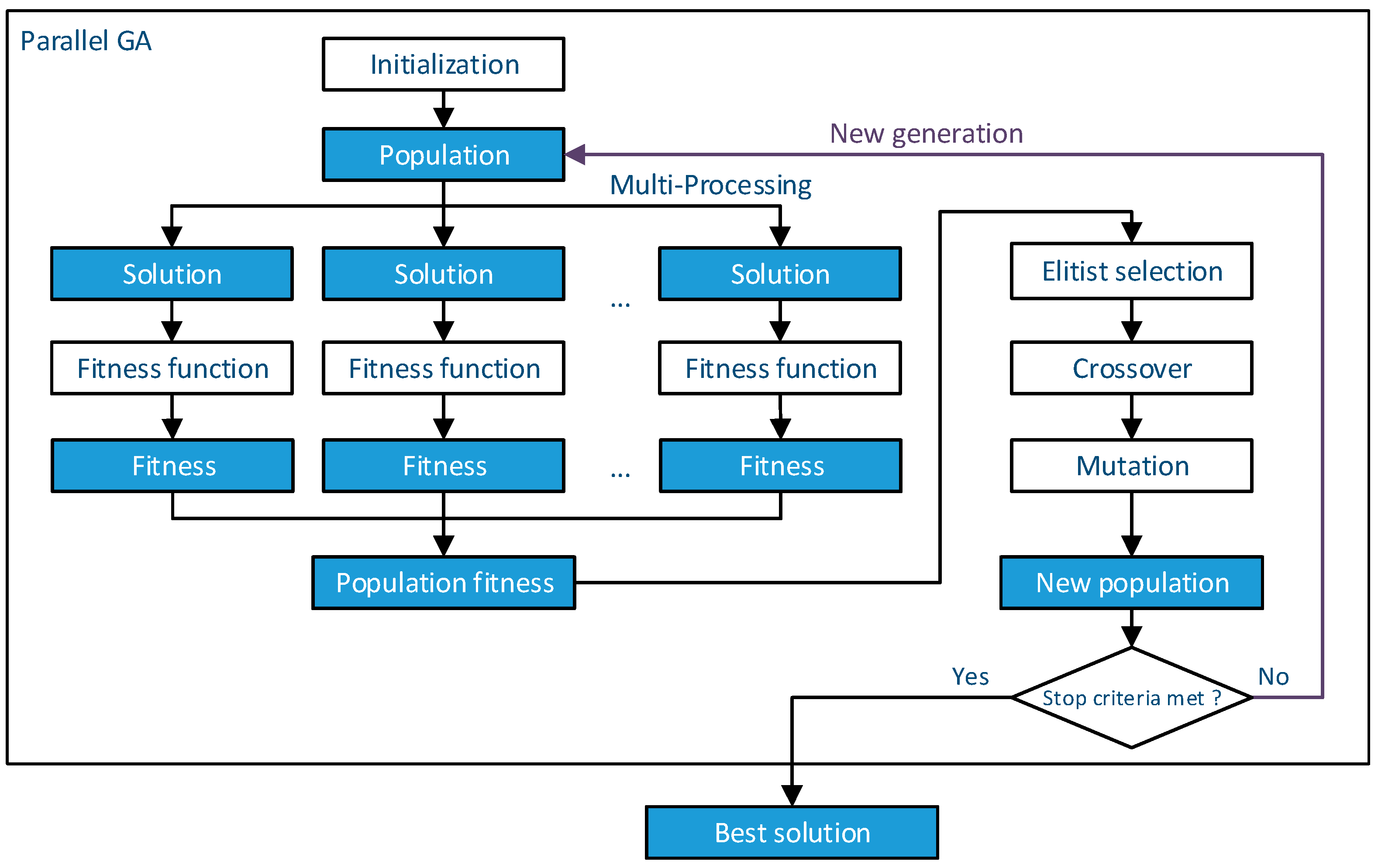

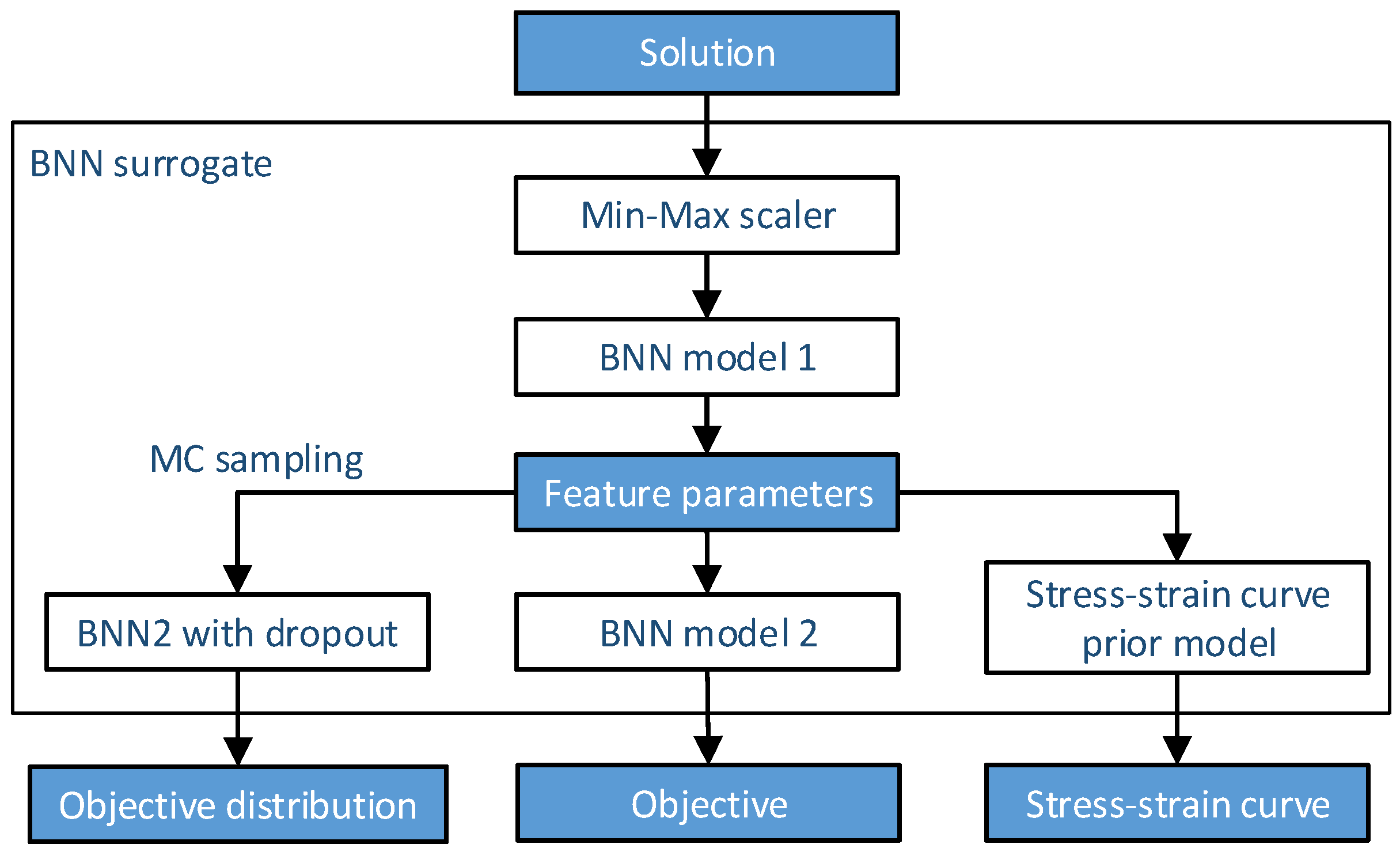
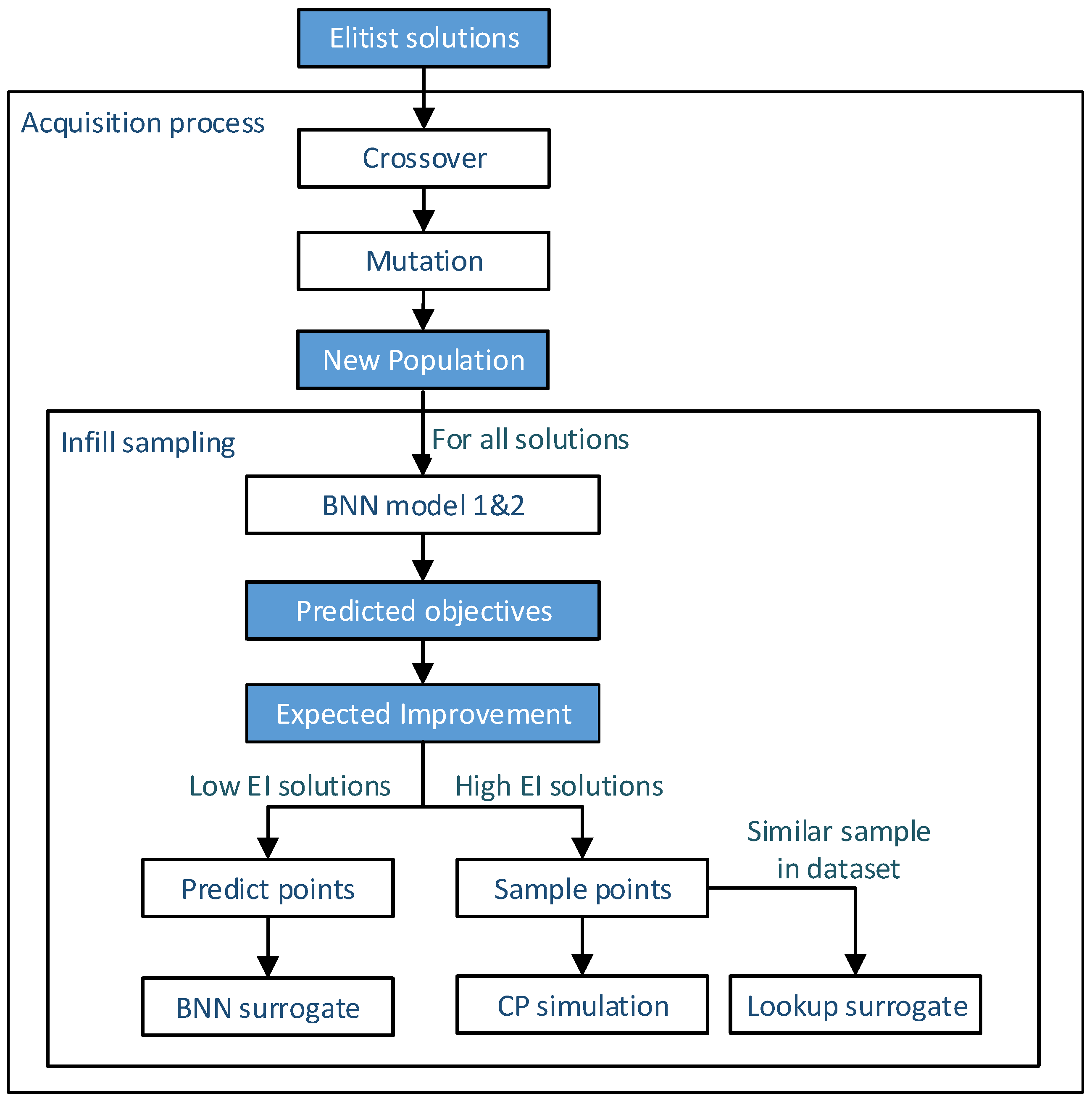
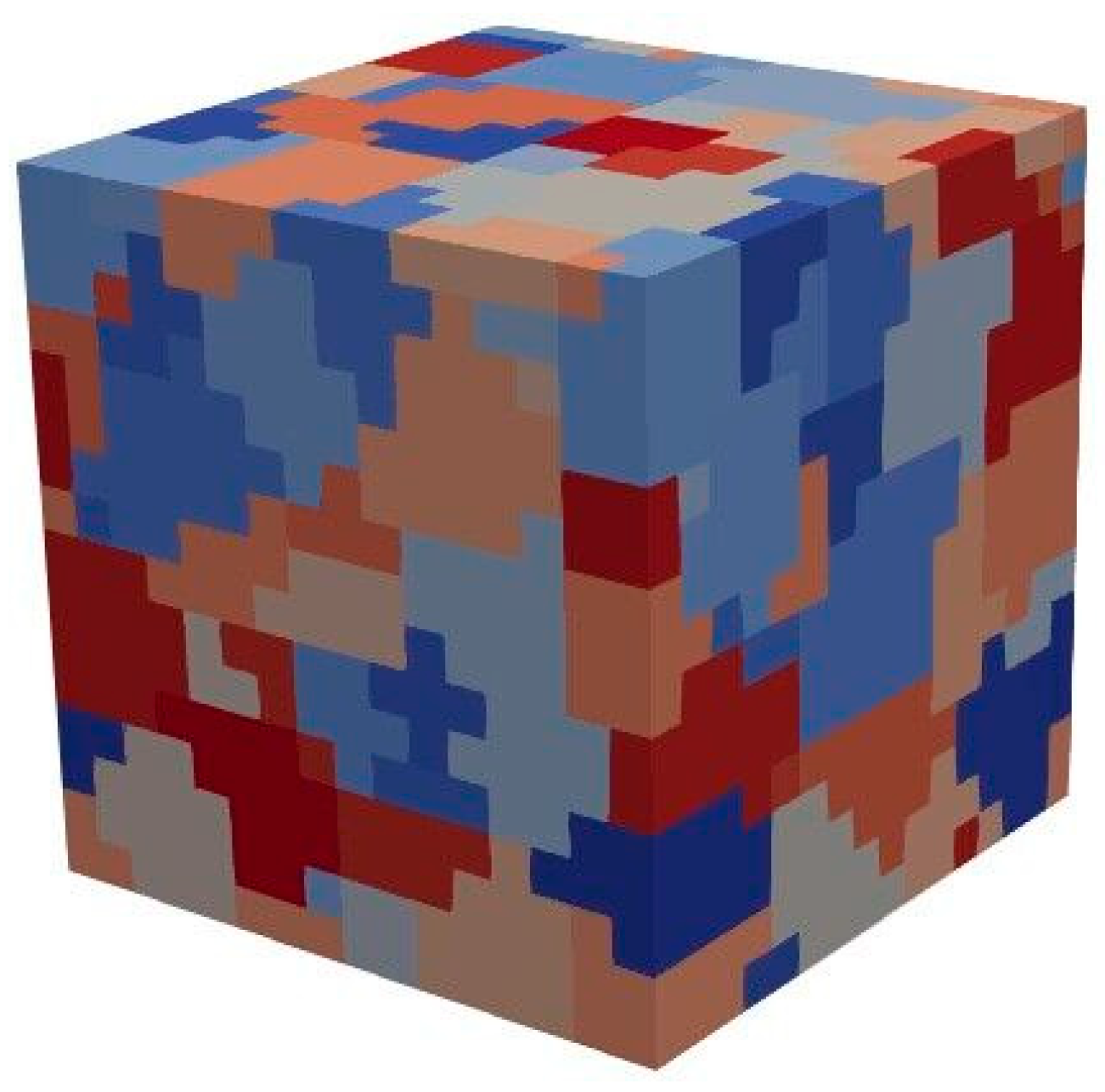
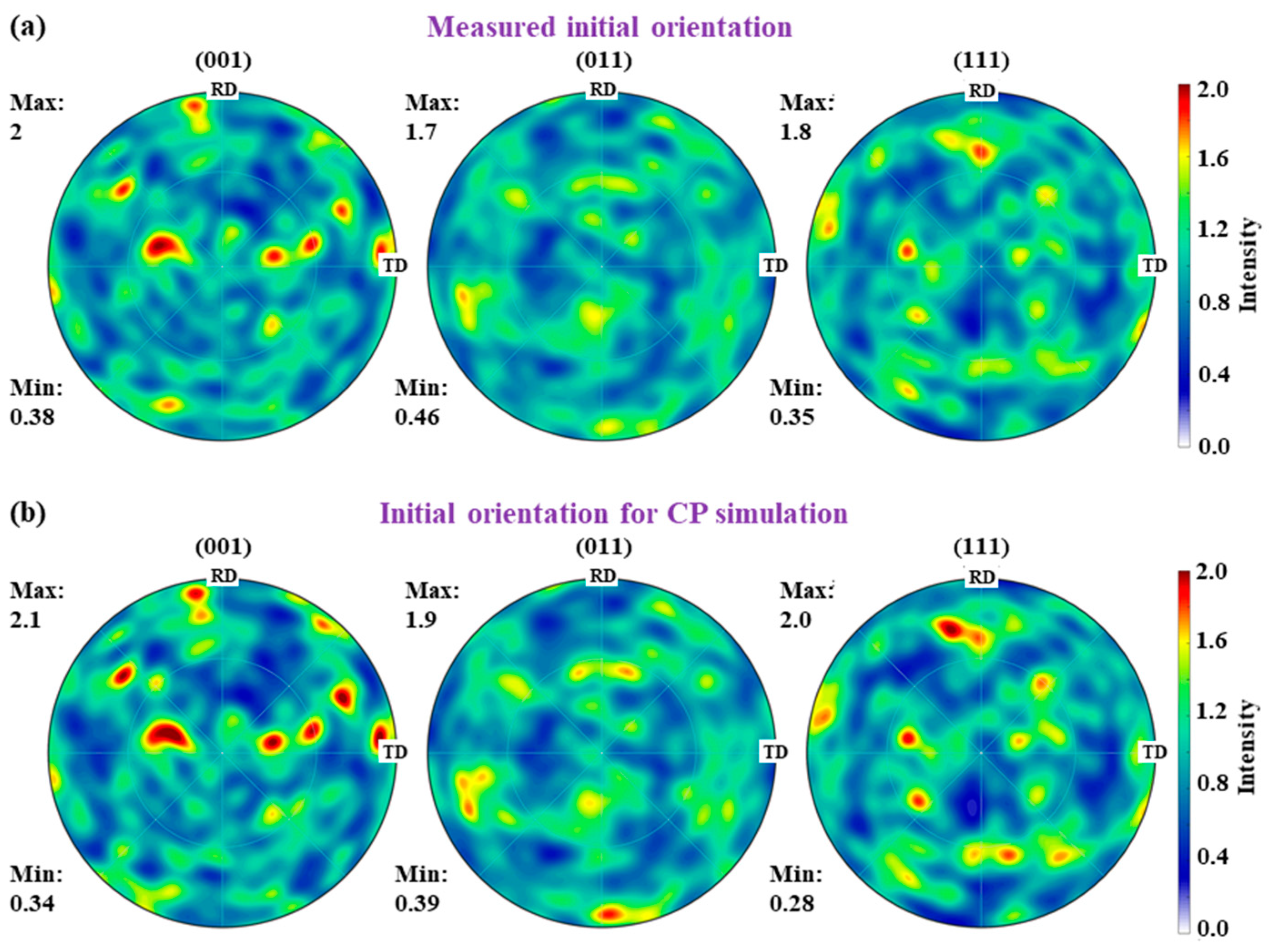

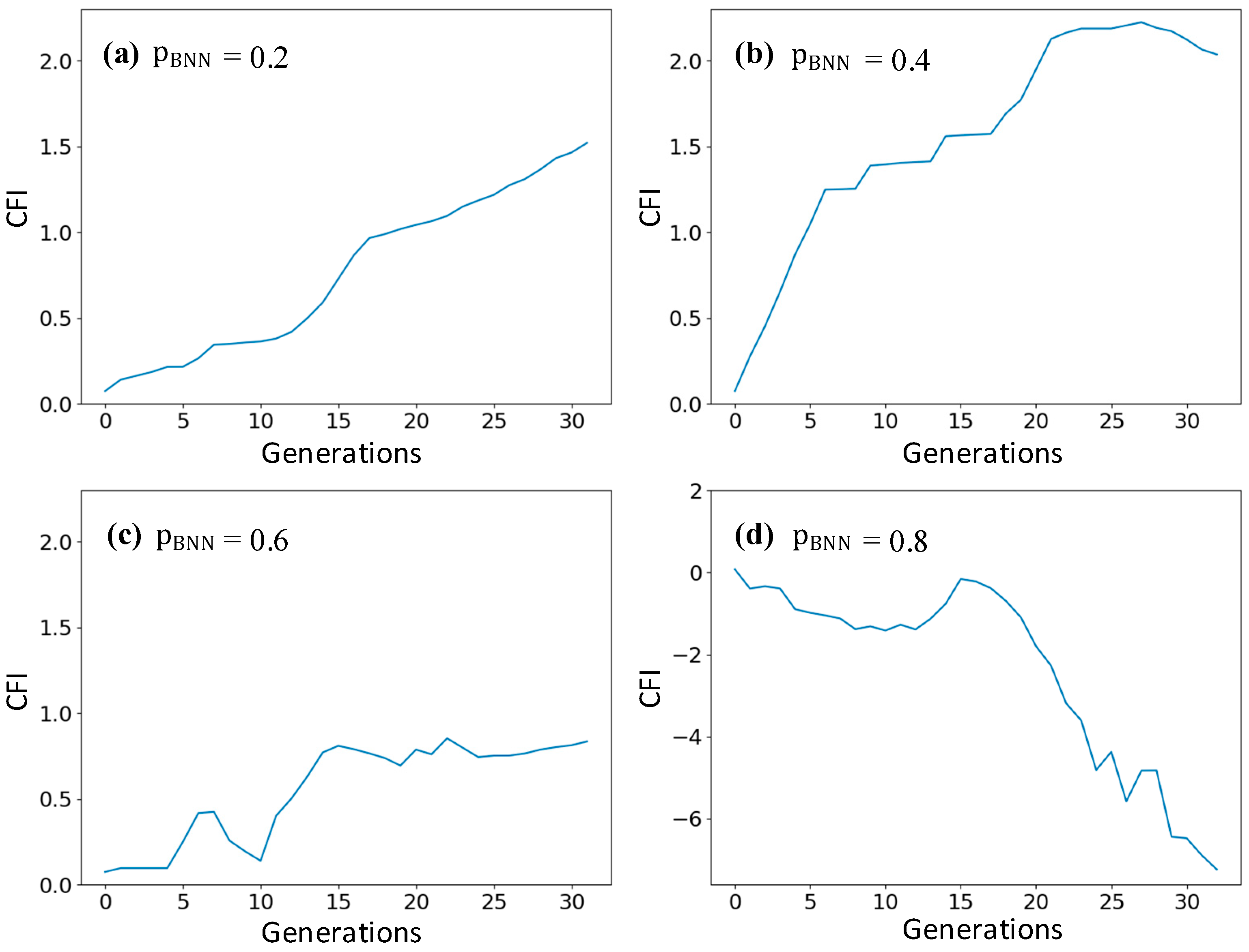
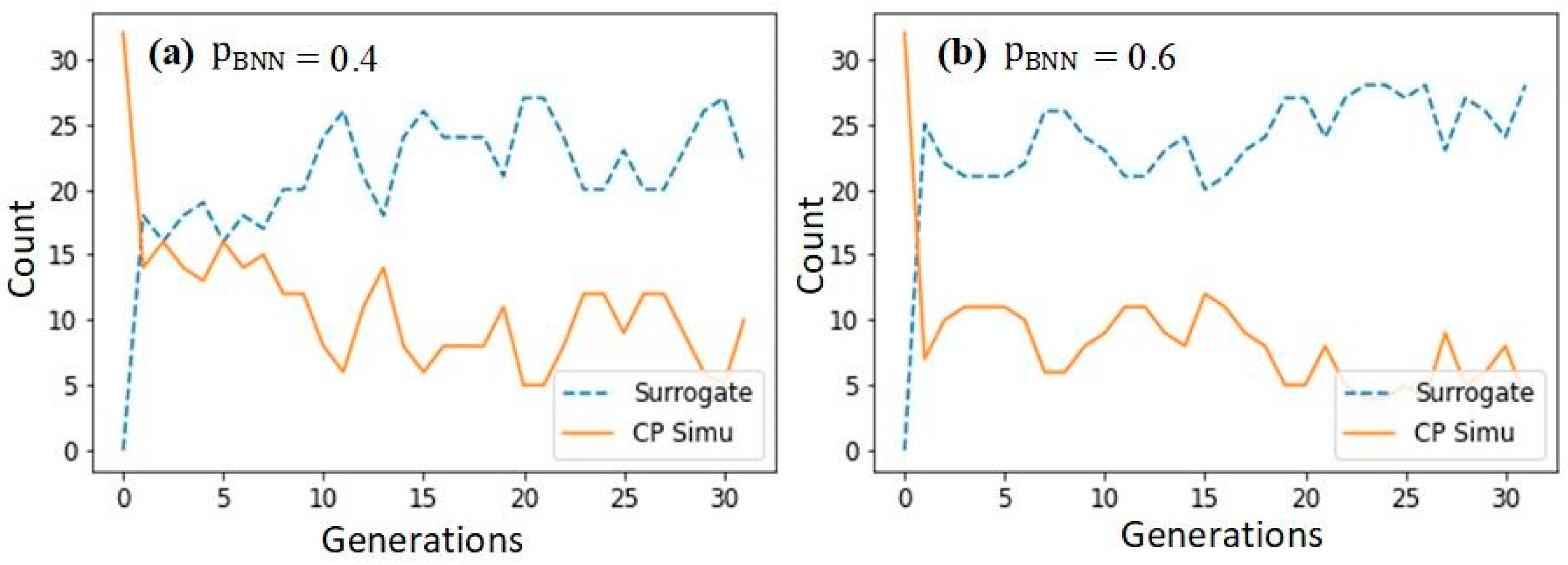



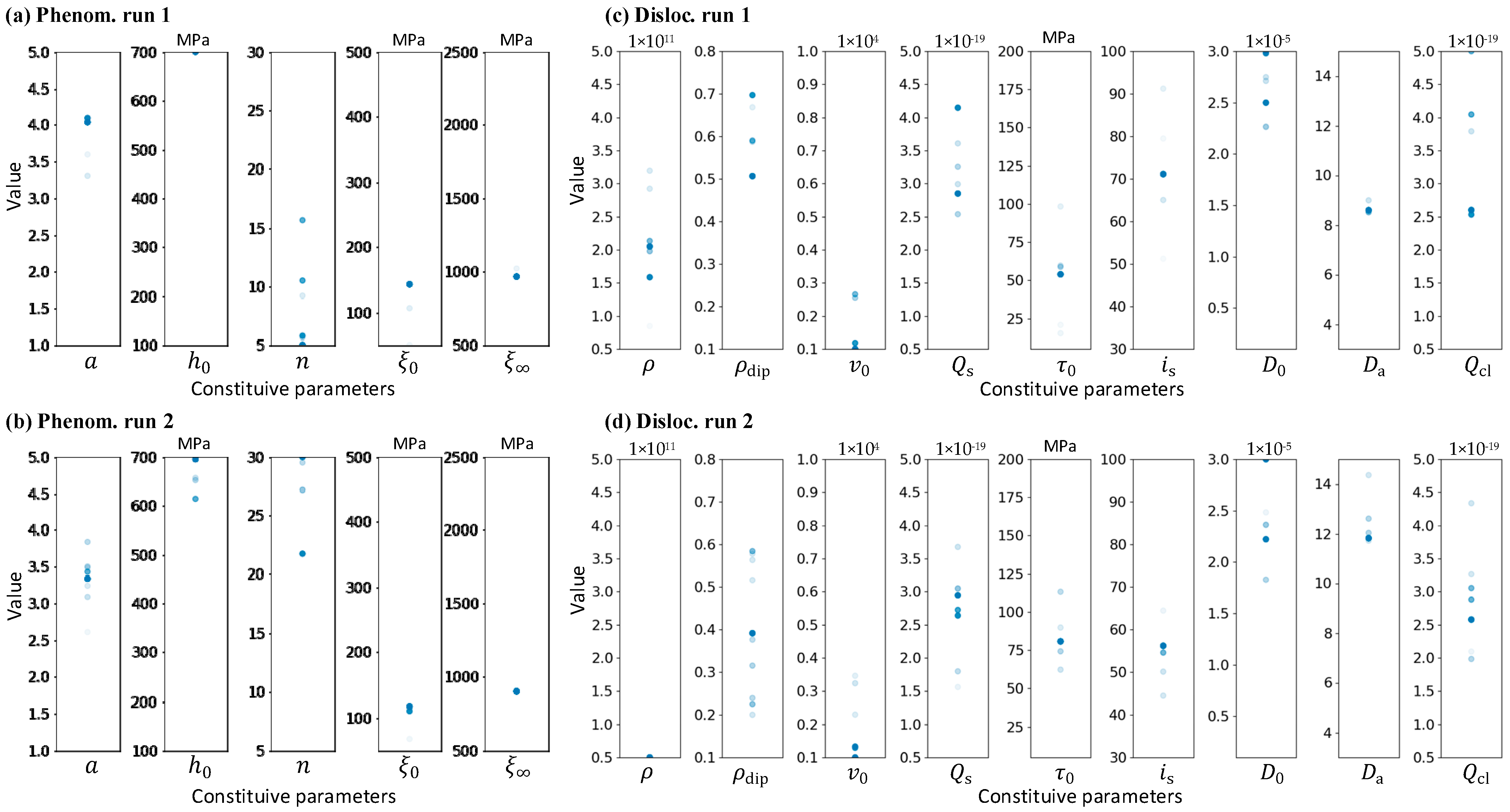
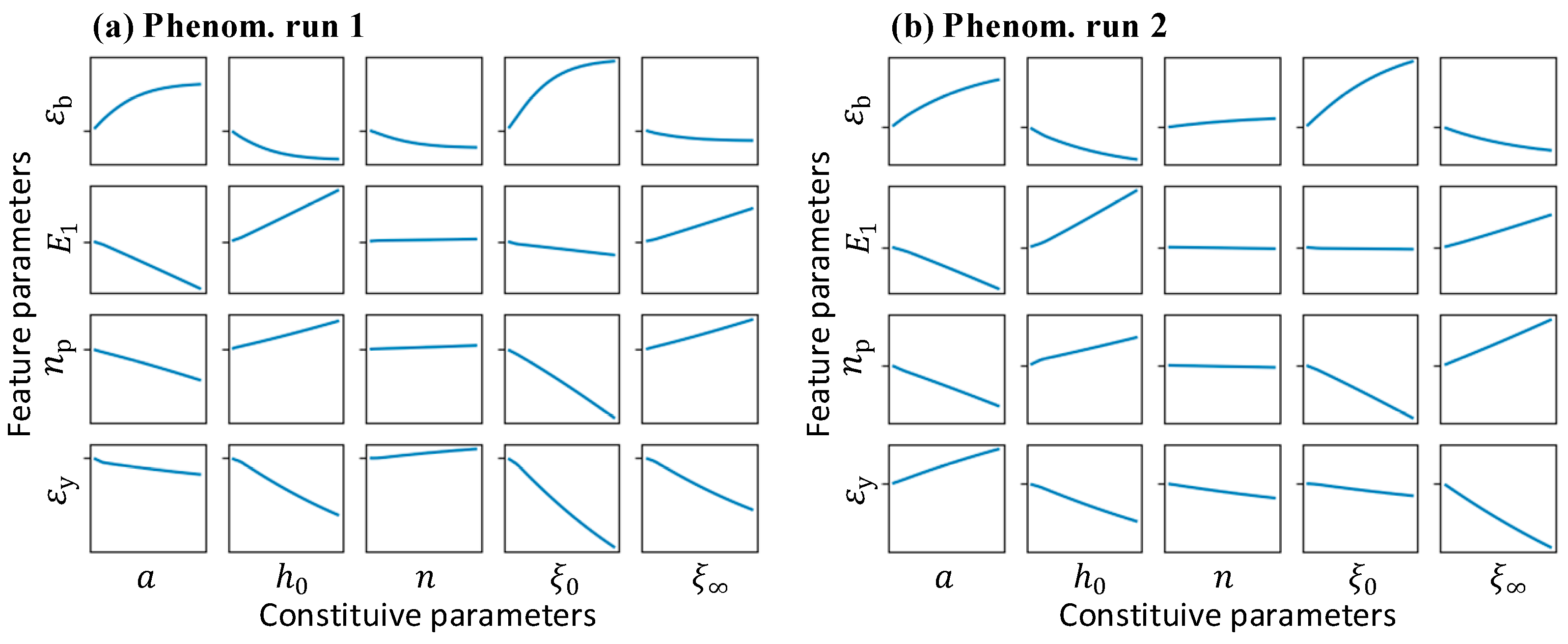
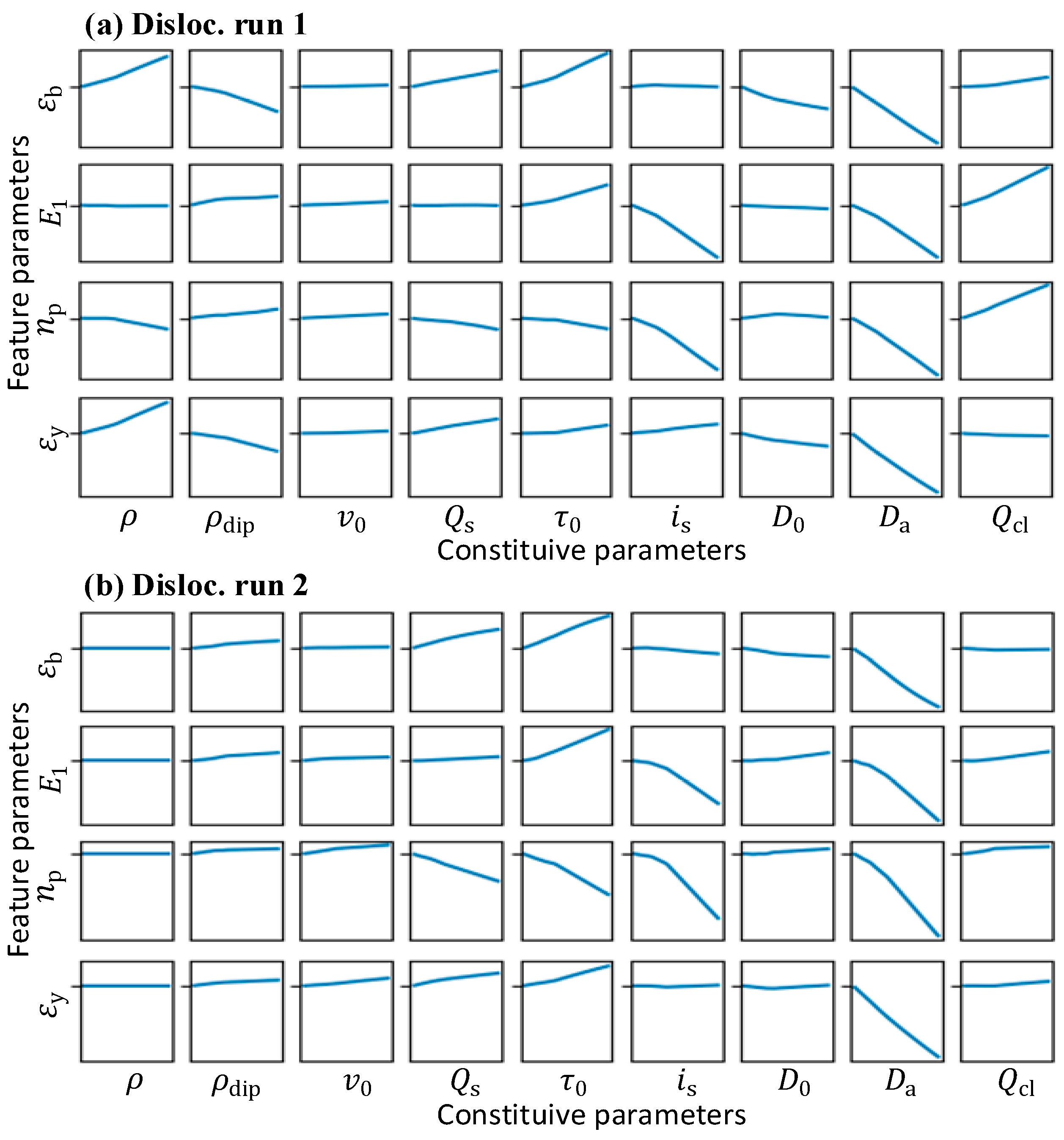
| Parameter | Value |
|---|---|
| Population size | 32 |
| Number of parents | 16 |
| Number of elitists | 4 |
| Mutation rate | 0.1 |
| Mutation type | Adding random value |
| Crossover rate | 0.2 |
| Crossover type | Single-point crossover |
| Number of parallel processing | 12 |
| Layers | Cell Number | Activation | Notes |
|---|---|---|---|
| Input layer | - | - | Normalized CP parameter |
| Dense layer 1 | 32 | ReLU | - |
| Dense layer 2 | 16 | ReLU | - |
| Output layer 1 | - | Sigmoid | Output the curve features |
| Dense layer 3 | 16 | ReLU | - |
| Dropout layer 1 | 16 | - | Dropout rate = 0.2 |
| Dense layer 4 | 8 | ReLU | - |
| Dropout layer 2 | 8 | - | Dropout rate = 0.2 |
| Output layer 2 | 1 | Sigmoid | Output the objective |
| Hyperparameters | Value |
|---|---|
| Batch size | 16 |
| Training epochs | 40 |
| Learning rate | 0.002 |
| Momentum decay | 0.9 |
| Scaling decay | 0.999 |
| Variable | Units | Value | Note |
|---|---|---|---|
| GPa | 245.1 | Elastic constant [35] | |
| GPa | 148.9 | Elastic constant [35] | |
| GPa | 191.5 | Elastic constant [35] | |
| 0.001 | Reference shear rate [32] | ||
| 2.54 × 10−10 | Burgers vector magnitude of slip system | ||
| - | 1.0 | p-exponent in glide velocity [34,36] | |
| - | 1.0 | q-exponent in glide velocity [34,36] |
| Variable | Units | Range | Note |
|---|---|---|---|
| MPa | [50, 500] | Slip resistance | |
| MPa | [500, 2500] | Saturation stress | |
| MPa | [100, 700] | Slip-hardening parameter | |
| - | [5, 30] | Strain rate sensitivity parameter | |
| - | [1, 5] | Slip-hardening parameter |
| Variable | Units | Range | Note |
|---|---|---|---|
| [5 × 1010, 5 × 1011] | Initial dislocation density | ||
| [0.1, 0.8] | Initial dipole dislocation density | ||
| [1000, 10000] | Initial glide velocity | ||
| [5 × 10−20, 5 × 10−19] | Activation energy for dislocation glide | ||
| [5 × 10−20, 5 × 10−19] | Activation energy for climb | ||
| MPa | [5.0, 200.0] | Solid solution strength | |
| - | [30.0, 100.0] | Controlling dislocation mean free path | |
| [1 × 10−6, 3 × 10−5] | Vacancy diffusion prefactor | ||
| - | [3.0, 15.0] | Minimum dipole distance |
| Hyperparameters | Value |
|---|---|
| Threshold for Lookup surrogate | 0.001 |
| Number of MCDropout samples | 40 |
| Proportion of BNN surrogate | 0.2, 0.4, 0.6, 0.8 |
| Variable | Units | Value (Run 1) | Value (Run 2) |
|---|---|---|---|
| MPa | 142.68 | ||
| MPa | 965.65 | ||
| MPa | 700.0 | ||
| - | 28.44 | 8.41 | |
| - | 3.34 | 4.09 |
| Variable | Units | Value (Run 1) | Value (Run 2) |
|---|---|---|---|
| - | 1.910 × 1011 | 5.682 × 1010 | |
| - | 0.571 | 0.391 | |
| 1745.177 | 3253.913 | ||
| 3.301 × 10−19 | 2.944 × 10−19 | ||
| 1.979 × 10−19 | 2.577 × 10−19 | ||
| MPa | 53.934 | 80.728 | |
| - | 71.101 | 56.150 | |
| 2.172 × 10−5 | 2.243 × 10−5 | ||
| - | 8.595 | 11.820 |
Disclaimer/Publisher’s Note: The statements, opinions and data contained in all publications are solely those of the individual author(s) and contributor(s) and not of MDPI and/or the editor(s). MDPI and/or the editor(s) disclaim responsibility for any injury to people or property resulting from any ideas, methods, instructions or products referred to in the content. |
© 2023 by the authors. Licensee MDPI, Basel, Switzerland. This article is an open access article distributed under the terms and conditions of the Creative Commons Attribution (CC BY) license (https://creativecommons.org/licenses/by/4.0/).
Share and Cite
Yang, S.; Tang, X.; Deng, L.; Gong, P.; Zhang, M.; Jin, J.; Wang, X. Interpretable Calibration of Crystal Plasticity Model Using a Bayesian Surrogate-Assisted Genetic Algorithm. Metals 2023, 13, 166. https://doi.org/10.3390/met13010166
Yang S, Tang X, Deng L, Gong P, Zhang M, Jin J, Wang X. Interpretable Calibration of Crystal Plasticity Model Using a Bayesian Surrogate-Assisted Genetic Algorithm. Metals. 2023; 13(1):166. https://doi.org/10.3390/met13010166
Chicago/Turabian StyleYang, Shuaiyi, Xuefeng Tang, Lei Deng, Pan Gong, Mao Zhang, Junsong Jin, and Xinyun Wang. 2023. "Interpretable Calibration of Crystal Plasticity Model Using a Bayesian Surrogate-Assisted Genetic Algorithm" Metals 13, no. 1: 166. https://doi.org/10.3390/met13010166
APA StyleYang, S., Tang, X., Deng, L., Gong, P., Zhang, M., Jin, J., & Wang, X. (2023). Interpretable Calibration of Crystal Plasticity Model Using a Bayesian Surrogate-Assisted Genetic Algorithm. Metals, 13(1), 166. https://doi.org/10.3390/met13010166










